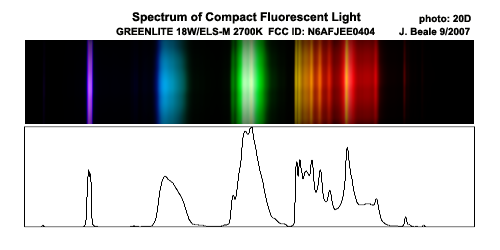Oh goodie! I can use my other hobby-knowledge (flashlight collecting).
Fluorescent lights produce white light by exciting mercury, which gives off light in a narrow spectrum spanning a bit of violet and then up into ultraviolet. This ultraviolet light is then converted by different phosphors that coat the inside of the glass. The
quality of light output (that is, the CRI, or "color rendering index", a 0-100 scale measuring how accurately colors are reproduced by a given light) is largely dependent on how many different phosphors are used to convert the UV light. Cheap-o fluorescence usually use 3 phosphors (that convert the UV to the three base colors with some UV left over), but more expensive ones (and I would argue most midrange ones nowadays) have 5 or more phosphors:


But even with all the extra spectrum "spikes" creating a more even white light, our brains know the difference. That's why even the best fluorescents one the market that mimic the color temp of incandescence can't render colors as accurately as incandescents (which have a CRI of 100) and often still look "harsh" to us. We've spent eons with the sun lighting our way (also with a CRI of 100).
I mention all the CFL business because LEDs are very similar.
Most white LEDs start life out as a blue or violet LED. Phosphors are then added onto the chip that strategically convert the higher wavelength light to other wavelengths. But LEDs tend to create a more even output than CFLs. But since most every consumer LED start out below the ultraviolet spectrum, there's no reason to add an element to the mix that
creates UV light. And any UV light produced would likely be very, very tiny compared to total light output.
The short answer is, I doubt the LED lamp is doing the damage. Despite very tight QC, no LED manufacturer can make two LEDs exactly the same (which is why you see different lot numbers that are separated by output at the factory, like Cree C5, S2, S3, etc., in higher end flashlights). But even with minute aberrations from the factory, the LED is still most likely starting its life out as blue or violet, not ultraviolet.
That's much more info than probably needed, but I will say that I agree with FarmBoy. UV detection paper or beads to see if your particular lamp spikes in the UV spectrum.















